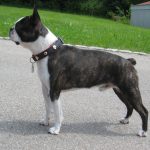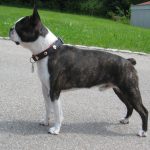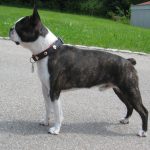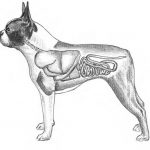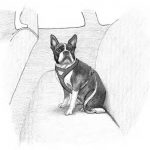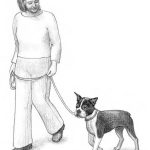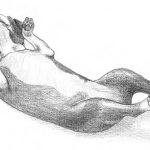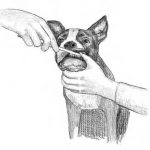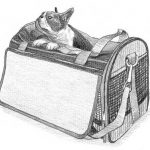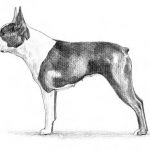In This Chapter
- Training your Boston for sport and obedience
- Joining a flyball or freestyle club
- Becoming a therapy dog
- Introducing dog shows and conformation trials
Training your Boston to sit and stay is one thing, but teaching your pup to strut in a show ring, deliver a smile to hospitalbound seniors, or weave in and out of challenging obstacles in an agility course takes her training to the next level.
Being as high-energy as any terrier, Bostons enjoy healthy doses of organized fun and frolic. Participating in one of the many events available to canines and their caretakers keeps her challenged and sharp — and her exuberance in check.
This chapter explores obedience, sport, and agility trials that will challenge you and your pup. You can also find out how your Boston can become a therapy dog and bring her gentlemanly joy to those who need it most. Finally, you discover the ins and outs of conformation trials (also known as dog shows). Chances are, your dog won’t be able to compete in a conformation trial because competitors can’t be spayed or neutered, but you can still gain lots of insight and information by attending the show as a spectator.
Training for Sport
Bostons love to compete in challenges that test their instincts and trained skills. The American Kennel Club offers all sorts of different activities for dogs of all breeds and groups, but the Boston qualifies for five: obedience, Canine Good Citizen, tracking, agility, and AKC Rally. These competitions center on how well your dog performs based on her natural abilities and your (or your handler’s) instruction.
For the well-behaved Boston: Canine Good Citizen program
Begun in 1989, the AKC’s
Canine Good Citizen (CGC)
program is designed to recognize dogs who demonstrate excellent manners at home and in the community. Often held in conjunction with or after puppy kindergarten and basic obedience training (see Chapter
Training and Behavior), the CGC program tests a dog’s ability to pass a series of obedience tests (listed below). Dogs who pass earn a certificate from the AKC and a dog tag inscribed with “Canine Good Citizen.”
Remember
The CGC program forms the foundation for many other kennel club and service dog activities and programs, including obedience trials, agility, tracking, and serving as a therapy dog. As you and your dog work through the tests and training, you solidify your bond with your Boston. Plus, the satisfaction of achieving a goal like this will likely lead you to continue training your Boston for other sporting events.
Unregistered? No problem!To participate in obedience, tracking, or agility trials, or to become a Canine Good Citizen, your Boston must be registered with the American Kennel Club. What if you want to compete, but your dog isn’t registered? Sometimes, people adopt purebred dogs who can’t be registered with the AKC. The dogs may have unregistered parents, their papers may have been lost, or they may have been abandoned and adopted by new owners from an animal shelter. They’re still purebred dogs, but they aren’t eligible for registration. In cases like these, the dog owner can apply for the Indefinite Listing Privilege program. It allows purebred dogs to participate in almost all AKC events, including agility, obedience, tracking, rally, and other group-specific trials. After she is enrolled in the ILP program, the dog is given an ILP number, which can be used in place of an AKC number on entry forms. Conformation trials, however, are one event in which an unregistered dog can’t participate. To compete in a dog show, the dog must be intact (not spayed or neutered); to enroll in the ILP program, the applicant must show proof from a veterinarian that the dog has been spayed or neutered. |
Any dog is eligible to participate in the CGC program, so even mixed breeds can earn their CGC certificate. All ages are welcome to join in the fun, too, though puppies who pass the test are encouraged to take the test again when they’re adults.
To qualify to take the test, you must first sign the AKC’s Responsible Dog Owners Pledge, which affirms that you agree to care for the dog’s health needs, safety, exercise, training, and quality of life. It also affirms that you agree to be responsible to the community by cleaning up after your dog and never letting her infringe on the rights of others.
After you sign the pledge, you’re ready to take the test. You’ll need to outfit your dog with a well-fitting buckle or slip collar made of leather, fabric, or chain. The test facilitator will provide a 20-foot leash for the test.
To earn her CGC certificate, your Boston has to successfully demonstrate the following ten test items:
– Accepting a friendly stranger: Allows a friendly stranger to approach you and talk to you.
– Sitting politely for petting: Allows a friendly stranger to pet her while she’s out with you.
– Appearance and grooming: Allows a stranger, such as a veterinarian or groomer, to examine and handle her. This test also demonstrates your dedication to your dog’s care.
– Out for a walk: Showing that you are in control, she walks attentively beside you while you hold a loose leash and make right, left, and about turns.
– Walking through a crowd: Demonstrates her ability to walk through a crowd of pedestrians.
– Staying in place: Shows that she obeys your Sit and Stay commands.
– Coming when called: Shows that she obeys your Come command.
– Reacting to another dog: Demonstrates that she behaves appropriately around other dogs.
– Reaction to distraction: Shows that she reacts confidently to distracting situations.
– Supervised separation: Demonstrates that she can be left alone with another person and maintain good manners.
You can find CGC training and testing programs through your kennel club, trainer, or some pet specialty stores.
Do as I say: Obedience trials
If your Boston excelled in her puppy kindergarten class, basic obedience training course, and Canine Good Citizen test, consider enrolling her in obedience competitions. Obedience trials, which were acknowledged by the AKC around 1935, require your Boston to perform specific exercises that show how well she obeys your commands.
AKC-registered dogs who are at least 6 months old can participate. To enter an obedience trial, you must submit an official AKC entry form to the trial secretary. After the entry period closes, you’ll receive a judging schedule for each class.
Obedience trials are broken into two categories:
– All-breed obedience trials, the most common trials, are open to all breeds and varieties recognized by the AKC.
– Specialty trials are limited to specific breeds or varieties of one breed.
Both types of trials have three graduating levels of competition: novice, open, and utility. Each level requires the dogs to complete a series of exercises, which become more challenging as they progress. By level, the exercises include:
– Novice: For dogs new to obedience trials, the exercises include heel on leash and figure eight, heel free, stand for examination, recall, long sit (1 minute), and long down (3 minutes).
– Open: This level is comprised of more-complicated exercises that prove the dog can obey verbal and signal commands, including heel free and figure eight, drop on recall, retrieve on flat, retrieve over high jump, broad jump, long sit (3 minutes), and long down (5 minutes).
– Utility: The highest level of competition, these exercises demonstrate obedience at its best, including signal exercise, scent discrimination, directed retrieve, moving stand and examination, and directed jumping.
In each level, the dog earns points when she successfully completes an exercise. She must earn at least half of the possible points in each exercise, earning a total score of at least 170 out of a possible 200. Each time your dog achieves this goal, she earns one leg toward her title in that particular level. After completing three legs in one level, your dog earns an obedience title.
Your Boston can progress through six different obedience titles:
– Companion Dog (CD): Earned when your dog has received three qualifying scores, or legs, in the Novice class.
– Companion Dog Excellent (CDX): Earned when your dog has earned three qualifying scores in the Open class.
– Utility Dog (UD): Earned when your dog has earned three qualifying scores in the Utility class.
– Utility Dog Excellent (UDX): Earned when dogs with UD titles earn qualifying scores at ten trials in Open B and Utility B.
– Obedience Trial Champion (OTCH): Earned when dogs with UD titles win 100 points and a first place in Utility B and Open B, plus a third first-place win in either class.
– National Obedience Champion (NOC): Awarded annually by the AKC to a dog who wins the AKC National Obedience Invitational.
As with the other training competitions, you can learn more through your local Boston Terrier or kennel club
Follow that scent: Tracking
Tracking, a type of obedience trial, tests the dog’s ability to recognize and trace a human’s scent, much like dogs do during search-andrescue operations. Just because your Boston has a short snout doesn’t mean she can’t track a scent!
The sport, originally called Obedience Test Field Trials, began in 1936 as part of the Obedience Trial’s Utility class. Since then, the sport’s tests have been refined to include more specific tracking exercises and adjusted to account for the ever-diminishing fields and open spaces.
Tracking tests are typically held in an open field, with the exception of the Variable Surface Tracking exercise that requires dogs to follow a scent through urban and wilderness environments.
Today, three tracking titles are available:
– Tracking Dog (TD): Dogs earn their TD title by following a 440- to 500-yard track with three to five changes in direction. The track is aged 30 minutes to two hours before the dog begins scenting. The goal is to locate the object that the tracklayer left behind.
– Tracking Dog Excellent (TDX): Upon earning their TD title, dogs earn their TDX title by following a longer (800 to 1,000 yards), older (three to five hours old) track that has five to seven directional changes and human cross tracks.
– Variable Surface Tracking (VST): A dog who earns her VST title has proved that she can follow a three- to five-hour-old track through an urban or wilderness setting.
– Champion Tracker (CT): The dog who earns TD, TDX, and VST titles bears the CT title.
Your kennel club can provide more information about training for and participating in these challenging competitions.
Boston be nimble, Boston be quick: Agility trials
What better way for a Boston to expend some energy than to participate in agility trials! This fast-growing canine sport challenges your dog’s nimble feet as she runs through a series of timed obstacle courses. Your dog responds to your cues as she races through jumps, tunnels, weave poles, and other obstacles.
The sport began in England in 1978. It made its official appearance in the United States when the AKC held its first agility trial in 1994.
Part of the lure of this fun sport is that dogs of all sizes can compete. The judges adjust the obstacles’ heights and vary the time allowance depending on the breed. People of all ages can compete, too, making it a sport for just about any fancier.
Rally togetherAre you ready for some fun? If you and your Boston think you want to try your hand — or paw — at agility or obedience trials but you’re not sure if you’re ready yet, AKC Rally is for you. Providing a link between the Canine Good Citizen program and agility or obedience trials, rally challenges you and your dog to race through a series of obstacles and exercises. Rally allows you and your Boston to move at your own pace through the course, which typically includes 10 to 20 stations with signs that tell you what to do. Scoring is not as rigorous as in traditional obedience, but communication and teamwork between you and your dog are highly encouraged. To be eligible to participate in rally, your Boston needs to be registered with the AKC and at least 6 months old. For more information, visit the AKC Web site ( www.akc.org) or talk to your Boston club representative. |
You and your Boston can compete in two agility classes:
– Standard Class: The Standard class features contact objects, such as an A-frame and a seesaw. Each obstacle has an area painted on the object, and the dog must place at least one paw in the area to complete the obstacle.
– Jumpers with Weaves: The Jumpers with Weaves class has only jumps, tunnels, and weave poles.
Both the Standard and Jumpers with Weaves classes have four increasing levels of difficulty: novice, open, excellent, and master. After a dog achieves Standard Master and Jumper Master, she can compete for the Master Agility Championship title.
Practicing for this event can be a challenge because the obstacles take up considerable space. But clubs across the country conduct practice matches, so if this competition interests you, talk to your local kennel club for more information.
Becoming a Therapy Dog
For those Bostons (and their owners) who enjoy giving back to their community, becoming a therapy dog is an opportunity to bring joy to hospital- or nursing home–bound children and seniors.
Well-behaved Bostons who have their Canine Good Citizen certificate are on their way to becoming therapy dogs. Different from service dogs that assist blind or otherwise disabled owners, some therapy dogs make informal visits to people in nursing homes and hospitals, while others participate in more structured sessions with people who are receiving physical therapy or coordination lessons.
Organizations such as Therapy Dogs International and the Delta Society evaluate potential therapy dogs and train those who show promise. Therapy dogs must
– Display sound temperament
– Be patient, confident, and at ease in a variety of situations, from busy hospital wards to sedate retirement homes
– Thrive on human contact, because one of their main purposes is to allow people to pet and dote on them
The organizations have different requirements for screening, testing, and certifying dogs to be therapy dogs. If you and your Boston are interested in pursuing this altruistic endeavor, talk to representatives from your local kennel club for details.
Making a differenceAs Jasmine, a Boston Terrier therapy dog from New Jersey, approached the myriad firefighters, counselors, Red Cross volunteers, and other relief workers after the World Trade Center attacks on September 11, 2001, she knew what she needed to do: offer them comfort, compassion, and a furry shoulder to cry on. Her owner, Nicole Hanson, recalls the therapy dogs’ impact: “Workers, military personnel, Red Cross and Salvation Army volunteers, American Airlines staff, and military chaplains alike seemed to ‘recharge’ with the dogs.” Bacon, another Boston Terrier therapy dog from Florida, provided the same loving support to Hurricane Katrina survivors in New Orleans in 2005. While children, still in shock from the traumatic events, mourned the loss of their homes and loved ones, Bacon brought a smile to their faces as they poured out their hearts to the canine counselor. “The way the children were responding to the dogs was so positive. Talking to and touching the dogs was a tremendous help,” says Bacon’s owner, Janet Morgan. “Bacon was just delighted with all the children.” Jasmine and Bacon approached these disasters with a wag of their short little tails, eager to help in any way possible. If your Boston shows a spark of compassion, behaves well with strangers, and possesses a true gentleman’s demeanor, consider applying for a therapy dog program in your area. |
Anecdotal and clinical evidence has shown that when people hold or pet an animal, their blood pressure drops, and their stress decreases. Pets can also pull people out of depression. Your Boston brings you joy at home, so why not share that joy with others in need?
Having Some Organized Fun
Outside the AKC or other kennel club circuit, you can engage your dog in organized and spontaneous sporting events. You can bring your Boston along to just about any activity you can imagine. Consider playing a fun game of Frisbee or fetch in the local dog park, hiking some scenic trails, or trolling the beach for shells with your best canine companion. It doesn’t get much better!
Two organized sports that you and your Boston may find fun and challenging are flyball, a timed relay race, and freestyle, a dance competition.
Why not try flyball?
Flyball is a timed relay race that pits two teams of four dogs against each other. In this game, at the signal, the first dog must run over a series of hurdles to a box of tennis balls and jump on a lever to send a ball flying. The dog then catches the ball and runs it to her owner. Then the next dog goes. This fun activity can burn a lot of Boston energy!
Your dog can earn ten titles in this fast-action sport, including Flyball Dog (FD), Flyball Dog Excellent (FDX), Flyball Dog Champion (FDCh), Flyball Master (FM), Flyball Master Excellent (FMX), Flyball Master Champion (FMCh), ONYX (named after the first dog to reach 20,000 points), and Flyball Grand Champion (FGDCh-30).
A group of trainers in Southern California invented Flyball in the late 1960s and 1970s. By the 1980s, the sport enjoyed huge popularity, thanks in part to a spot on The Tonight Show Starring Johnny Carson. The first flyball organization, the North American Flyball Association (NAFA), formed in 1984 to design uniform competition rules and tout the sport as one that could be enjoyed by virtually every dog.
The sport currently enjoys international representation, with clubs in the United States, South Africa, Australia, and the United Kingdom.
If your Boston loves to catch tennis balls, seek out a flyball club in your area. You can find a list of clubs on the NAFA Web site (
www.flyball.org) or on the United Flyball League International Web site (
www.u-fli.com).
Dancing with the dogs: Canine freestyle
Canine freestyle is a human-dog choreographed dance that incorporates obedience commands like Sit and Stay. The object of the sport is for you and your dog to display innovative and original dance using movements to showcase teamwork, creativity, costumes, and style while interpreting the theme of the music.
Begun in the late 1980s in Canada, freestyle made its way to the United States in the 1990s, appearing at various demonstrations across the country. By the mid ’90s, competitive teams developed, and major sponsors joined in the fun. Two approaches to the sport — and two organizations — began to diverge: the Canine Freestyle Federation (CFF), which emphasized the dogs and their movement; and the Musical Canine Sports International (MCSI), which emphasized the handler’s costuming and movement.
Today, several organizations regulate competitive canine freestyle, including the CFF, MCSI, World Canine Freestyle Organization, and Musical Dog Sport Association. Competitions differ from group to group, but generally, titles are awarded to high scores in technical merit and artistic impression.
Attending a Conformation Trial
If you’re like most Boston owners, you probably think that your dog looks perfect — or very close to perfect! Her markings make her unique, her temperament is top-notch, and her conformation is in a class by itself.
Conformation trials, or dog shows, give you the opportunity to see and interact firsthand with other beautiful purebred dogs. Because you’ve most likely had your Boston spayed (or neutered), she is ineligible to compete against the other four-legged beauties. But you can attend dog shows to appreciate the sport and learn more about the various breeds.
One of the most well-known conformation dog shows, the Westminster Kennel Club Dog Show, held annually at Madison Square Garden in New York, has been showcasing the best of the best since 1877. The show, which was initiated by a group of hunters who frequently met at the Westminster Hotel in Manhattan, originated as a sport for hunting dogs. The men formed the Westminster Kennel Club, one of the first kennel clubs in the United States with the purpose of showing dogs.
Bostons who compete in dog shows are judged based on how well they meet the
breed standard, which is the ideal physical representation of the breed as described by the American Kennel Club-sanctioned Boston Terrier Club of America. You can read more about the Boston breed standard in Chapter
Tracking the Boston Terrier.
Conformation dog shows are organized three ways:
– All-breed shows: The type most often televised, these shows offer competitions for more than 150 breeds and varieties of dogs recognized by one of the major dog registries, such as the AKC.
– Specialty shows: These shows, often hosted by breed clubs, highlight one specific breed or varieties of a breed. For example, Bostons can complete in the Boston Terrier Club of America Specialty.
– Group shows: These shows are limited to dogs within a particular group, such as the Non-sporting, Hound, or Herding Group. Bostons fall within the Non-sporting Group, so they would compete with the Bichon Frise, Lhasa Apso, and Poodle.
The judges who critique the dogs must be experts in the breeds in which they are judging. During conformation, judges
- Examine the dogs from head to toe
- Feel their bones, muscles, and coat texture
- Examine the dog’s teeth, eyes, and ears
- View each dog’s profile for overall balance
- Watch the dogs strut their stuff to check their gait
After the judges have evaluated the dogs, they present awards to the best examples of the breed based on the breed standard. The dogs don’t don a tiara and cape, but they do take home points toward their titles and colorful ribbons to decorate their walls.
Being an informed spectator
Usually publicized in the local media and hosted by an area allbreed or breed-specific club, dog shows can introduce you to the world of showing, give you an opportunity to meet with other purebred-dog owners, and allow you to talk to the club’s representatives about how you can join.
Tip
As a spectator, make the most of attending a show by remembering these tips:
– Go to learn. Observe the participants’ etiquette. Marvel at the different dog varieties. Talk to as many breeders and handlers as possible. Speak with other spectators and swap fun stories about your Boston. Take the opportunity to learn as much as you can about the dog fancy.
– Visit the grooming area. For grooming suggestions, talk to the professional groomers about how to keep your Boston looking her best.
– Do not touch a dog before speaking with her owner or handler first. No matter how tempting it may be to wish a pup good luck and stroke her coat, ask for permission. You wouldn’t want to muss a dog’s coat right before she hits the show floor!
– Wear comfortable clothing and shoes. You’ll be doing a lot of walking and standing while watching the various matches, and seating may be limited, depending on the venue.
– If you take your child to the show, keep a constant eye on him. Do not allow him to grab a dog’s tail, reach his hand into a kennel, or approach a dog on her way to the show floor. Instruct him to respect the dogs and their handlers at all times.
– Chat with vendors. Dog shows typically host a number of vendors who sell all sorts of merchandise, from Bostonspecific gifts, food, and treats to toys, beds, and dog houses. You’ll also find representatives from area kennel clubs and sporting clubs. Talk to them about how to get involved.
After attending several dog shows, you’ll want to join your local Boston Terrier club (if you haven’t already!). Not only is the group an excellent resource for health and care information, but it also provides a wealth of information about other competitions in which you and your spayed Boston can participate.
Understanding the points
In dog shows, a competitor’s goal is to rack up points toward his dog’s AKC championship or Champion of Record title. After the dog earns her Champion of Record title, she can compete for the Best of Breed title, in the group competition and, ultimately, for the Best in Show award.
Technical Stuff
To earn a Champion of Record title, a dog must earn 15 points, including two majors (wins of 3, 4, or 5 points) awarded by at least three different judges. The number of points awarded in any match depends on the number of dogs in the competition. The maximum number that can be earned is 5; the minimum is 1.
Here’s how a dog show works:
Dogs earning points toward their championships are first separated by breed, and then by gender. For example, Bostons are separated from the other breeds and then divided into male and female groups. The males and females are broken down further into six classes:
– Puppy: Dogs between 6 and 12 months old who are not yet champions
– 12 to 18 months: Dogs between 12 and 18 months old who are not yet champions
– Novice: Dogs 6 months of age and older who have not won the Novice, Bred by Exhibitor, American Bred, or Open class, and have not earned points toward their championship
– Bred by Exhibitor: Dogs who are shown by their owner and breeder who are not yet champions
– American Bred: Dogs who are mated and born in the United States who are not yet champions
– Open: For any dog at least 6 months old
The first-place winners of the classes then compete against each other to determine which is the best of the winning dogs. The judges award championship points (from 1 to 5, depending on the number of dogs in the competition) to the best male (Winners Dog) and the best female (Winners Bitch).
The Winners Dog and the Winners Bitch then compete with the dogs who have already earned their Champion of Record title. This competition is called Best of the Breed Competition.
Typically, three awards are during the Best of Breed Competition:
- Best of Breed: The dog deemed best in its breed category
- Best of Winners: The dog judged better between the Winners Dog and the Winners Bitch
- Best of Opposite Sex: The best dog who is the opposite sex of the Best of Breed
Only the Best of Breed advances to compete in the Group competitions. Group winners then compete against each other for the ultimate prize: Best in Show.
Competition for children and dogs
Junior Showmanship classes, which are open to children ages 9 to 18 years old, offer the opportunity for budding fanciers to develop their handling skills, learn about good sportsmanship, and learn about dogs and dog shows.
Leonard Brumby Sr. and a group of dog handlers conceived Children’s Handling in the late 1920s. Today the competition is known as Junior Showmanship, and it allows children to be judged on how well they present their dogs.
Dressing the part“Coordinating outfits” take on a whole new meaning when it comes to dog shows. At point shows, the dog handlers — whether it’s the dog owner or someone he hires — typically dress to enhance the dog’s appearance. They choose solid colors, like black, blue, or brown, which draw attention to the dog’s coat. Careful not to wear something that draws attention away from the dog’s beauty, they often don modest outfits, such as a shirt, tie, and sports coat for the men and a dress or two-piece suit for the women. The outfits always have plenty of pockets for treats and brushes, and they are cut for free movement — which is essential when running in the ring or kneeling on the floor. |
The competitions include handling and performance events, similar to those offered for adults. Judges evaluate the children’s handling methods, not the animals, though the dogs do need to be registered with the AKC.
As with adult shows, several classes and subclasses divide the competitors. The children are broken into Novice and Open classes. Novice classes, which offer the youngsters an opportunity to gain experience in the trials, are for those who have not yet won three first-place awards. Open classes are for those who have three or more first-place wins.
The classes break down further into age groups. Juniors are 9 years old but under 12, Intermediate competitors are children 12 years old but under 15, and Seniors are children 15 years old but under 18.
Tip
If your child shows interest in Junior Showmanship, encourage it! Many junior handlers continue with their love of dogs to become professional handlers, veterinarians, breeders, and trainers.
Take your child to the Junior Showmanship classes at a regional dog show and talk with him about the different levels of competition. Check with your Boston Terrier club about handling classes designed especially for young people.
by Wendy Bedwell-Wilson
